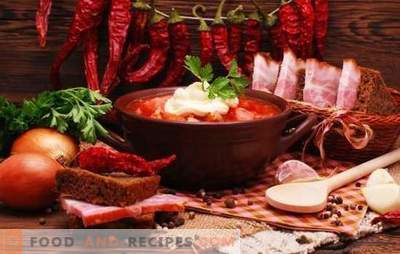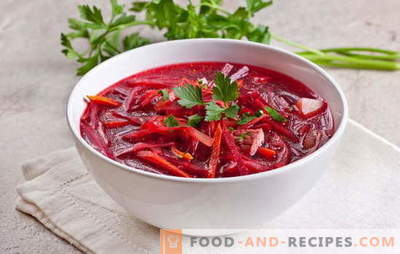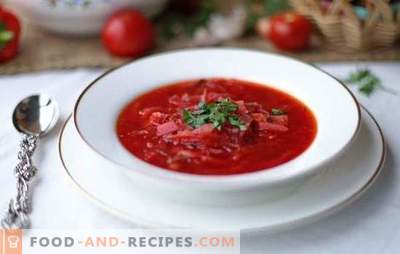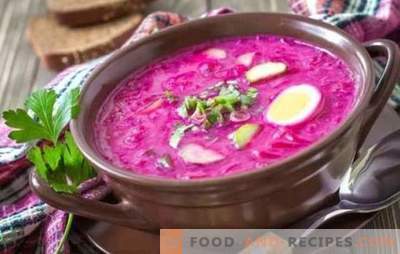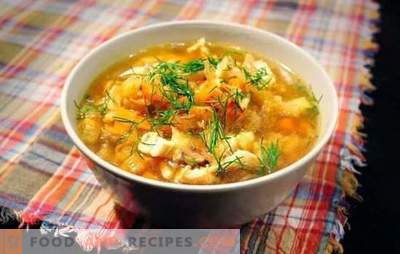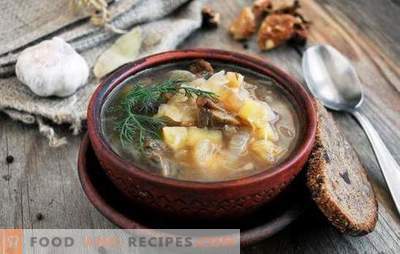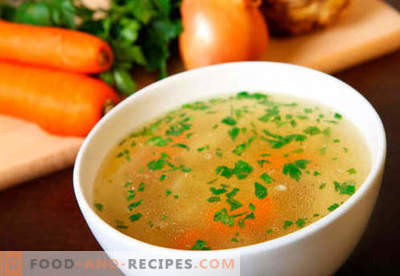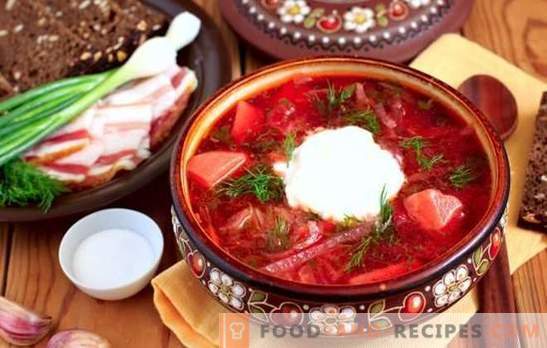
Borsch, as well as soup, is a dish with history, with the only difference being that it has beet. This root crop is the main feature of the first dish of South Russian, and subsequently - Ukrainian cuisine, as well as all peoples inhabiting the South Russian lands since the beginning of the ninth century. It was at that time that beetroot first appeared on the territory of the Old Russian state.
What you need to know to cook real Ukrainian borscht? On the basic intricacies of its preparation - in step-by-step recipes and tips.
Step-by-step recipe of cooking Ukrainian borscht - the basic technological principles
The taste and nutritional value of the first dishes in Slavic cuisine is in the technology of cooking broth. Delicious broth - the dish is half done! This rule is the same for borscht and cabbage soup, with the only difference that classic soup is made from beef or veal, and the broth for classic Ukrainian borscht is made from pork.
But lately, step-by-step recipes for Ukrainian borscht have become more democratic in using the most expensive ingredients, and expensive pork or beef in their recipe may well be replaced by chicken or bone set. By the way, the tubular bones make the most rich and tasty broth.
Borsch is a dish that has many cooking options in regional cuisines, but South Russian borsch is fundamentally different from Moscow or Siberian borsch. The difference lies in the ordering of product bookmarks and, in some cases, in the ways of their preliminary preparation.
Of course, speaking of the step-by-step recipe for cooking borsch, one cannot help but dwell on the preparation of beets. Now this root crop is spread throughout Russia, but the experience of using it in the first courses first came to the southern part, as the vegetable was originally a southern and heat-loving plant, while breeders did not work on breeding many varieties. Accordingly, the experience of its use in cooking first spread in the south of Russia. Kuban and Don Cossacks, the Ukrainian “state gifts” earlier than others noticed that there are table beet varieties that are better used for salads and vinaigrettes, and there are roots with less saturated coloring, from which they cook borsch in the south.
For some reason, housewives in the northern regions of the country believe that borsch should have a rich burgundy color, which is surprising Ukrainian women who boil the beetle (Ukr.) Until the broth is completely cleared, trying to prevent the potatoes from staining pink, and then laying it out.
Ukrainian borsch, like all the first dishes of Slavic cuisine, is seasoned with sour ingredients, but this is not sauerkraut, as in shchi, but tomato dressing, or sorrel and cow parsnip (chard is a kind of leaf beet) in the spring versions of a step-by-step recipe. The peculiarity of the Poltava borscht: the gas station is cooked in fat. Lenten Ukrainian borsch is seasoned with vegetable oil, and beans and mushrooms are added to thicken it; in some regions of Ukraine, dumplings are cooked for thickening borscht - a kind of dumplings, pastry flour products - the influence of Polish cuisine.
Traditional Ukrainian borsch - one step-by-step recipe in three versions
Ingredients:
For broth:
Meat and meat and bone set 1.8-2.0 kg
Water 4.5 L
Roots: parsley, celery, carrots, onions
Spices: Jamaican and black pepper (peas), coriander, bay leaf
Spicy greens: dill, parsley
For refueling:
Tomatoes (pasta, mashed potatoes, juice, optional)
Onion
Carrot
Fat (pork or vegetable)
Fresh cabbage
Parsley and dill leaves
Salad and hot pepper
Garlic
Potatoes
Ground spices and salt to taste
Beans
Cooking Technology:
First, there are general technological recommendations on the amount of ingredients and the consistency of Ukrainian borscht: in the step-by-step recipe only the weight of meat and the volume of water are indicated, in order to understand that the broth must be saturated. The remaining ingredients are added exclusively to taste and so that the ratio of liquid and solid ingredients in the dish is the same. In the Slavic cuisine before the beginning of the Peter the Great, when the national cuisine was significantly influenced by French chefs, in the recipes of Russian dishes there was no such thing as an exact measure, and all the components were added “by eye”. The French lawmakers in cooking worked, of course, only in the master's kitchen, and from there the “exact recipe” passed, over time, into the taverns, into the Soviet public catering and remained until the present time in the technological maps of cafes and restaurants.
In folk Slavic cuisine, weight measures have never been used, and this principle has also been preserved in home Russian (and Ukrainian) cuisine until now. This explains the diversity of soup and borscht - each family has its own preferences.
Now you can do the cooking broth. You need to boil it for a long time, because the meat should cook over low heat, and during this time you can prepare all the other ingredients to shorten the cooking process.
1. Broth pay attention to the maximum. Wash the meat. From his choice depends on the time of cooking, but in the end cooked meat should be easily separated from the bone. Wash it.
If you use pork, then soak it in acidified water: this technique will help reduce the amount of harmful cholesterol. For soaking, prepare a 10% solution of table vinegar. Of course, it is better to do this in advance, a couple of hours before the start of cooking.
For other types of meat, soaking is desirable. In the process of cooking meat, foam is formed, which must be removed so that the broth is clean and transparent, but if the meat is previously kept in water, then you can save yourself from care, stand with a skimmer over boiling meat broth.
2. Prepare spicy roots and carrots: wash and peel.
3. Medium-sized single onion wash and cut only the roots, leaving the top golden scales, which will give the broth a beautiful color.
4. Prepare fresh greens: wash, separate the large green stems from the leaves. Tie the stalks in a bundle using a thread, and lay the leaves temporarily to one side.
5. Choose a pot of the right size. After immersing meat in it and filling it with cold water, there should be free space - 5-7 cm from the water surface to the edge. 6. Immerse the meat and bones in cold water. If you cook from the pulp then, for example, salads, then immerse the meat in boiling water: in this case, it preserves its taste and juiciness during cooking. If the meat is intended only for borscht, then it is boiled, dipped in cold water, then taken out of the prepared broth, cut into portions and added to the plates when serving.
7. Add peeled roots and onions. Put the pot on the fire. Boil for about an hour. Try to pierce the flesh - the meat should be easy to crawl with a fork or knife. At this point, you can drop parsley and dill stalks in a broth, tied in a bun, add bay leaf, peppercorns, coriander seeds - if desired.
8. After ten minutes, get the meat and bones, put it on a plate. Strain the broth and pour back into the pan. Let it boil. Broth ready. It can be cooked in advance.
It was a step-by-step recipe for cooking broth, which is prepared for all the first courses of Russian cuisine, exactly the same, and from that moment begins the preparation of homemade Ukrainian borscht.
9. Beets are boiled for a long time, so you need to start working with her. Wash, clean the root crop of medium size - 150-200 g. Choose not dark pulp, but lighter, with a striped pattern on the cut - it will quickly digest and will not stain potatoes.
There are two variants of preliminary preparation of beets: you can grate peeled beets on a large grater and put them in boiling broth, or pre-put grated beets in a small amount of vegetable oil, and then put them in broth. Cook over low heat, just like meat, covering the pan with a lid.
In stores sold gas station for borsch, with beets. Some housewives add it to borscht at the very end of cooking, along with a sour dressing, but this step-by-step recipe has nothing to do with Ukrainian borscht. The dish gets red color only due to the addition of tomato dressing, and the soup should not be burgundy. All other variants of borsch are more reminiscent of the technology of beetroot soup or botvinia. 10. While the beets are boiling in the broth until full clarification, prepare the remaining ingredients: wash, peel and dice the potatoes; chop the bell peppers, cabbage, chop the parsley and dill leaves. If desired, prepare 2-3 cloves of garlic, chopped them finely, hot peppers. Transfer all this green mass into a separate container in order to immerse it in the pan with borsch at the very last moment.
11. Prepare a tomato dressing. For the summer version of borscht, you can use fresh tomatoes. Blanch them, wipe through a sieve. It will take about 1 kg of vegetables. Bringed mashed potatoes bring to a boil. To make the color of borscht more saturated, you can add tomato paste or sauce to fresh mashed potatoes, but make sure that the dish is not too sour.
12. Dice 2-3 medium sized onions, rub carrots.
13. To pass the onions and carrots in a deep frying pan, heat the fat. Here are also possible options: melted lard (lard - ukr.), Bacon, vegetable oil, margarine or melted butter. You can use different combinations of the listed products.
Fat should be pre-cut into small cubes and melt the fat in a hot frying pan. If desired, the heated pieces of pork bacon can be removed from the pan with a slotted spoon, or left by adding them along with the dressing to the borsch.
14. In the heated fat, place the carrots, after 3-4 minutes, when the carrots are soft, add onions. Simmer the vegetables until the onions are transparent, and then pour the tomato puree into the pan. Adjust the temperature by setting the minimum level; extinguish the dressing until the liquid evaporates. During this time, the tomato will acquire a dark red saturated color.
15. When the beetroot boils and the broth becomes bright yellow, and the beetroot slices become transparent white, put the potatoes in a pan, and cook it until ready, but do not overcook.
16. Add the finished tomato dressing and let the borscht boil.
17. Now you can put pepper, salt, bay leaf to refresh the flavor of the broth. After 2-3 minutes, put the chopped cabbage and the rest of the greens. Immediately after boiling, turn off the heat, cover the pan with a lid and leave for 20-30 minutes. 18. You can serve. Put the pieces of meat in the plates, soup, add sour cream or mustard.
Mushrooms or beans for adding to borsch should be pre-wetted, kept in cold water, washed and boiled. These ingredients are added to borsch along with potatoes.
Step-by-step recipe of Ukrainian borscht - useful tips
- Large vegetables contain more fiber. This also applies to beets. Try to choose small roots, as they contain less coarse fibers, which are cooked for a long time and even after that remain quite tough and coarse in taste.
- To make the beetroot more tasty, pass it in vegetable oil, adding a little sugar. Do the same with carrots and onions.
- Ukrainian borscht with meat retains its flavor even for two to three days. Before serving, it is enough to warm it up, not boiling it. To restore the flavor, add fresh greens and slightly chopped cabbage when warming up. Borscht will seem fresh even the day after its preparation.
- Lenten Ukrainian borsch is cooked in vegetable oil and vegetable broth: slightly adjust the recipe described above. Instead of meat broth, use mushroom decoction or broth from the beans. But for lean borsch, beetroots must be first extinguished, because in ordinary water it becomes not very pleasant color and taste.





